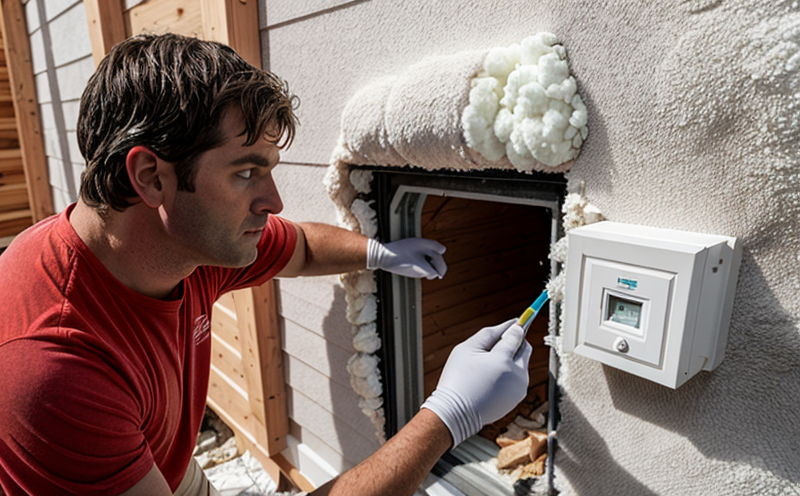ISO 8302 Heat Flow Measurement on Building Panels
The ISO 8302 standard is widely recognized for its role in evaluating the thermal performance of building panels. This method quantifies heat flow through a test specimen, which helps manufacturers and engineers ensure compliance with energy efficiency standards. Understanding this process is crucial for quality managers, compliance officers, R&D engineers, and procurement teams involved in building & infrastructure projects.
The test involves measuring steady-state heat flow through a flat, homogeneous, and isotropic material or composite panel under controlled conditions. The apparatus used includes a calorimeter that maintains the specimen at a constant temperature gradient across its thickness. The heat flux is then measured using thermocouples placed on both surfaces of the sample.
Specimen preparation for this test requires careful attention to detail. Specimens must be cut from the same batch as those intended for use in the final product, ensuring consistency in composition and manufacturing process. Environmental conditions during testing should mimic real-world scenarios as closely as possible; therefore, specimens are often conditioned at specified temperatures and humidities before being placed into the calorimeter.
The test results provide valuable insights into how well a particular insulation material or composite panel will perform under various environmental conditions. Compliance with ISO 8302 not only ensures that products meet regulatory requirements but also contributes to more energy-efficient buildings, reducing operational costs and environmental impact.
Compliance with this standard is essential for manufacturers aiming to gain market access in countries adhering to stringent energy efficiency regulations like those set forth by the International Energy Agency (IEA) or the European Union's Ecodesign Directive. Additionally, successful completion of ISO 8302 testing can enhance brand reputation and customer trust.
It is worth noting that while ISO 8302 provides a standardized approach to evaluating thermal performance, it does not address all aspects of insulation materials. For instance, it focuses primarily on steady-state conditions rather than transient behavior or dynamic changes in temperature. However, when used in conjunction with other tests such as those outlined in ASTM C518 for determining thermal conductivity, ISO 8302 offers a comprehensive view of a material's performance.
Benefits
Implementing ISO 8302 heat flow measurement offers several key advantages:
- Enhanced Product Quality: Ensures that building panels meet strict thermal insulation standards, leading to higher product quality and reliability.
- Energy Efficiency: By optimizing the thermal performance of buildings, this test contributes significantly to reducing energy consumption and associated costs.
- Regulatory Compliance: Helps manufacturers comply with international and national regulations regarding building materials and their energy efficiency.
- Market Differentiation: Provides a competitive edge by demonstrating commitment to sustainability and innovation in product development.
In summary, adopting ISO 8302 heat flow measurement enhances both the technical performance of products and business competitiveness within the market.
Industry Applications
| Application | Description |
|---|---|
| Building Insulation: | Evaluating the thermal performance of insulating materials used in walls, roofs, and floors. |
| Cool Roof Technology: | Assessing reflective properties which contribute to reduced heat gain inside buildings during summer months. |
| Solar Panel Installation: | Understanding the interaction between solar panels and building envelopes regarding heat transfer. |
| Energy Efficient Windows: | Testing the insulating properties of window frames and glass to improve overall building insulation. |
The application of ISO 8302 extends beyond just construction materials, influencing various sectors including renewable energy systems where efficient heat management plays a vital role in system performance.
Competitive Advantage and Market Impact
Adopting ISO 8302 heat flow measurement can significantly enhance a company's competitive advantage by providing accurate data on the thermal performance of building panels. This information allows manufacturers to tailor their products more closely to customer needs, thereby improving customer satisfaction.
In addition, compliance with this standard can open up new markets where stringent energy efficiency regulations are in place. For example, many countries within the European Union have implemented policies mandating high levels of insulation in new buildings. Being able to demonstrate compliance with ISO 8302 gives manufacturers a clear path towards accessing these lucrative markets.
The use of this testing method also fosters innovation by encouraging continuous improvement in product design and manufacturing processes. As standards evolve, so too must the technologies that support them. This dynamic environment drives forward-thinking companies to stay ahead of competitors who may not prioritize such rigorous testing methods.





